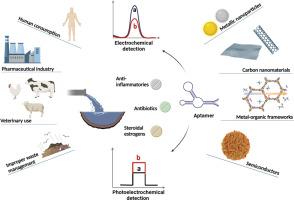用于环境药物污染物检测的电化学和光电电化学感应传感器
IF 5.6
3区 材料科学
Q1 ELECTROCHEMISTRY
引用次数: 0
摘要
药用物质是新兴的污染物,由于其持久性,有可能显著降低环境质量。评估环境污染是一个关键的研究领域,可以受益于现场,负担得起的和易于获得的分析方法。本文综述了利用适体作为药物污染物识别元件的电化学生物传感器的最新进展。考虑到环境浓度、毒性和选择的适体等因素,解释了选择抗生素、非甾体抗炎药和雌激素激素背后的定量配给。对研究文献中使用的适配体,其特征和功能化进行了彻底的修订。解释了适体与电化学和光电化学传感器的耦合,并详细介绍了信号配准的机理。一个重要的焦点是适体传感器的构建,其中材料和适体的集成强烈影响生物传感器的成本,复杂性和性能。所使用的主要材料被分类为碳基、金属和半导体,并在每种情况下使用共价和非共价适配体固定的理由。通过检出限、线性范围和选择性等参数系统地评价了分析性能。经过整体分析,得出了电化学感应传感器是否可以应用于环境分析的结论,并讨论了其局限性和可能的改进。本文章由计算机程序翻译,如有差异,请以英文原文为准。

Electrochemical and photoelectrochemical aptasensors for the detection of environmental pharmaceutical pollutants
Pharmaceutical substances are emerging contaminants with the potential to significantly lower the quality of the environment due to their persistence. Evaluating environmental pollution is a critical area of research that can benefit from on-site, affordable, and accessible analytical methods.
This review highlights recent advancements in electrochemical biosensors that use aptamers as recognition elements for pharmaceutical contaminants. The reasoning behind the selection of antibiotics, non-steroidal anti-inflammatories, and estrogen hormones is explained, considering factors such as environmental concentrations, toxicity, and selected aptamers. A thorough revision of the aptamers used in the studied literature, their characteristics, and functionalization was done. The coupling of aptamers with an electrochemical and photoelectrochemical transducer was explained, and the mechanisms for signal registration were detailed.
An important focus was the construction of the aptasensors, where the materials and the integration of aptamers strongly influence the cost, complexity, and performance of the biosensor. The main materials used were classified into carbon-based, metallic, and semiconductors, with a justification for the use of covalent and non-covalent aptamer immobilization in each case. The analytical performance was systematically evaluated through parameters like the limit of detection, linearity range, and selectivity. After the global analysis, a conclusion as to whether electrochemical aptasensors can be applied to environmental analysis is reached, with limitations and possible improvements debated.
求助全文
通过发布文献求助,成功后即可免费获取论文全文。
去求助
来源期刊

Electrochimica Acta
工程技术-电化学
CiteScore
11.30
自引率
6.10%
发文量
1634
审稿时长
41 days
期刊介绍:
Electrochimica Acta is an international journal. It is intended for the publication of both original work and reviews in the field of electrochemistry. Electrochemistry should be interpreted to mean any of the research fields covered by the Divisions of the International Society of Electrochemistry listed below, as well as emerging scientific domains covered by ISE New Topics Committee.
 求助内容:
求助内容: 应助结果提醒方式:
应助结果提醒方式:


